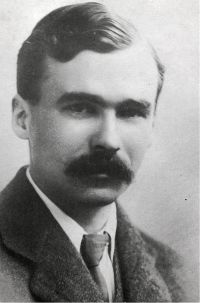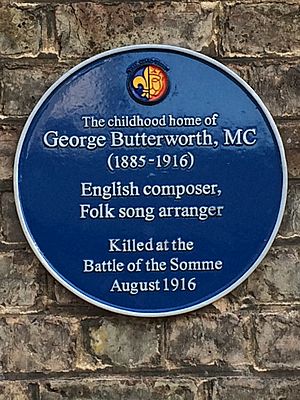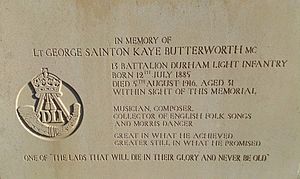George Butterworth facts for kids
Quick facts for kids
George Butterworth
|
|
|---|---|

George Butterworth, c. 1914
|
|
| Born |
George Sainton Kaye Butterworth
12 July 1885 Paddington, London, England
|
| Died | 5 August 1916 (aged 31) Pozières, Somme, France
|
| Cause of death | Killed in action |
| Resting place | Unknown |
| Nationality | English |
| Education |
|
| Alma mater | Trinity College, Oxford |
| Occupation | Composer, schoolmaster, music critic, professional morris dancer, soldier |
| Parent(s) | Sir Alexander Kaye Butterworth; Julia Marguerite Wigan |
| Relatives | Joseph Butterworth (great great grandfather) Hugh Butterworth (cousin) |
| Military career | |
| Allegiance | |
| Service/ |
|
| Years of service | 1914–1916 |
| Rank | Subaltern |
| Unit | 13th Battalion, Durham Light Infantry |
| Battles/wars | First World War |
George Sainton Kaye Butterworth, who received the MC, was an English composer. He lived from July 12, 1885, to August 5, 1916. He is best known for his beautiful orchestral piece The Banks of Green Willow. He also wrote many songs based on A. E. Housman's poems from A Shropshire Lad.
Contents
Early Life and Music

George Butterworth was born in Paddington, London. Soon after he was born, his family moved to York. His father, Sir Alexander Kaye Butterworth, became a manager for the North Eastern Railway there. Their home was a house called Riseholme. In 2016, a special blue plaque was placed on the building to remember him.
George's mother, who was a singer, gave him his first music lessons. He started composing music when he was very young. As a boy, he played the organ for church services at his school, Aysgarth School. Later, he won a scholarship to Eton College. He showed great musical talent at Eton, even having an orchestral piece played there.
After Eton, Butterworth went to Trinity College, Oxford. There, he focused more on music and became the head of the University Music Club. He made friends with important people like Cecil Sharp, who collected folk songs, and the composer Ralph Vaughan Williams. He also met Hugh Allen, who later directed the Royal College of Music, and Adrian Boult, a future conductor.
Butterworth and Vaughan Williams often traveled around England to collect folk songs. Butterworth himself collected over 450 songs, many in Sussex. Their own music was greatly influenced by these folk tunes. George Butterworth was also a skilled folk dancer, especially good at morris dancing. He even worked as a professional morris dancer for the English Folk Dance and Song Society.
After Oxford, Butterworth started a career in music. He wrote music reviews for The Times, composed, and taught at Radley College. He also briefly studied piano and organ at the Royal College of Music. He didn't stay long because he preferred a less academic life.
Butterworth and Vaughan Williams became very close friends. Butterworth even suggested that Vaughan Williams turn one of his pieces into his famous London Symphony. When the original music for this symphony was lost during World War I, Butterworth helped Vaughan Williams recreate it. After Butterworth's death, Vaughan Williams dedicated the symphony to his memory.
Service in World War I
When the First World War began, George Butterworth joined the British Army. He started as a private soldier in the Duke of Cornwall's Light Infantry. Soon, he became an officer, a 2nd Lieutenant, in the 13th Battalion of the Durham Light Infantry. He was later promoted to Lieutenant.
Butterworth admired the ordinary miners from County Durham who served in his group of soldiers. His battalion was sent to fight in the Battle of the Somme. They were ordered to capture parts of the village of Contalmaison. Butterworth and his men successfully captured trenches near Pozières in July 1916. He was slightly wounded during this action. For his bravery, Lieutenant George Butterworth was awarded the Military Cross. He was 31 years old, but he died before he could receive the medal.
The Battle of the Somme was very intense. On August 4, Butterworth's division was told to attack a German trench called Munster Alley. The soldiers dug a new trench for the attack and named it 'Butterworth Trench' in his honor. In fierce fighting during the night of August 4–5, Butterworth and his men captured Munster Alley. They held it despite heavy losses. Early on August 5, a German sniper shot Butterworth in the head. He died instantly. His soldiers quickly buried his body in the trench. However, his body was never found later for a proper burial due to the heavy bombing.
Butterworth's brigade commander wrote to his father to tell him about his death. His father had not known that George had won the Military Cross. The commander was also surprised to learn that Butterworth was a very promising English composer. He wrote that Butterworth was "A brilliant musician in times of peace, and an equally brilliant soldier in times of stress."
There has been some confusion about how many awards Butterworth received. Some people thought he won the Military Cross twice, but this is not correct. He was mentioned for his bravery several times. He was recommended for the Military Cross for his courage in July. He was then successfully awarded it for leading his company well while wounded. However, the Military Cross was not given to soldiers after they died at that time. So, he could not have received it twice.
George Butterworth's body was never officially recovered. His name is listed on the Thiepval Memorial in France. His piece The Banks of Green Willow has become a symbol of the young people who died in the war. It is seen by some as an anthem for all 'Unknown Soldiers'. Butterworth's father put up a plaque at St Mary's Priory Church, Deerhurst to remember George and his nephew, Hugh Butterworth, who also died in the war. Most of Butterworth's original music papers were given to Vaughan Williams. After Vaughan Williams died, these papers were placed in the Bodleian Library in Oxford.
His Musical Works
Butterworth did not write a huge amount of music. Before and during the war, he destroyed many pieces he didn't like. He did this in case he didn't return from the war and couldn't revise them. Among the works that still exist, his songs based on A. E. Housman's poems from A Shropshire Lad are very famous. Many English composers of his time set Housman's poetry to music.
In 1911 and 1912, Butterworth wrote eleven songs using Housman's poems. Some of these poems include:
- "Loveliest of Trees"
- "When I Was One and Twenty"
- "Is My Team Ploughing?"
- "The Lads in Their Hundreds"
He did not use any known folk tunes in these songs. The songs were dedicated to Victor Annesley Barrington-Kennett, a friend from school and Oxford, who also died in France in 1916. The songs were published in two sets: Six Songs from A Shropshire Lad and Bredon Hill and Other Songs. "Is My Team Ploughing?" is the most famous song. Another song, "Loveliest of Trees," is the basis for his 1912 orchestral piece, also called A Shropshire Lad.
People often connect the sad and death-focused themes in A Shropshire Lad to Butterworth's own death in the war. For example, the song "The lads in their hundreds" talks about young men who leave home to 'die in their glory and never be old'.
The Rhapsody, A Shropshire Lad is an orchestral piece that uses a full symphony orchestra. It was first performed in 1913. Butterworth also wrote other short orchestral works based on folk songs he collected. These include Two English Idylls (1911) and The Banks of Green Willow (1913). These pieces are often performed and recorded, especially The Banks of Green Willow.
Another work, Love Blows As the Wind Blows, uses poems by W. E. Henley. It exists in different forms: for voice and piano, voice and string quartet, or voice and small orchestra. The orchestral version was the last music Butterworth worked on before going to France. It shows his knowledge of other composers' styles, like Vaughan Williams.
George Butterworth showed great musical talent. His pieces like Two English Idylls and The Banks of Green Willow show how well he could use folk songs in his larger works. His original music, like the Rhapsody: A Shropshire Lad, has a delicate quality. It reminds some people of composers like Debussy. It is possible that he had stopped composing before he went to France. We can only wonder what other amazing music he might have created if he had lived.
List of Compositions
Butterworth's complete works that still exist are:
- Two English Idylls for orchestra (1910–1911)
- A Shropshire Lad, Rhapsody for orchestra (1911)
- The Banks of Green Willow for orchestra (1913)
- Love Blows As the Wind Blows, a song cycle for voice and piano (or string quartet) (both 1911–12) or small orchestra (1914) [words William Ernest Henley]
- Suite for String Quartet (1910)
- Eleven Songs from A Shropshire Lad (including Six Songs from A Shropshire Lad, and Bredon Hill and Other Songs) (1910–1911) [words A. E. Housman]
- Folk Songs From Sussex (1912)
- Haste On, My Joys!, song (date unknown, probably before 1906) [words Robert Bridges]
- I Will Make You Brooches (date unknown) [words Robert Louis Stevenson]
- I Fear Thy Kisses (1909) [words Percy Bysshe Shelley]
- Requiescat, song (1911) [words Oscar Wilde]
- In The Highlands, for female voices and piano (possibly 1912) [words R. L. Stevenson]
- On Christmas Night, for male chorus (possibly 1912) [folksong]
- We Get Up In The Morn, for male chorus (possibly 1912) [folksong]
- Morris Dance Tunes Books 8 & 9 (1914)
Arrangements of Butterworth's compositions
- Fantasia for Orchestra (1914), edited and completed by Martin Yates
- Fantasia for Orchestra (1914), edited and completed by Kriss Russman
- Two English Idylls (arranged for piano duet by John Mitchell) (1999)
- A Shropshire Lad: Rhapsody (arranged for piano by John Mitchell) (2011)
- Suite for Small Orchestra (arrangement of the Suite for String Quartet by Phillip Brookes) (2012)
- Suite for String Quartette (arranged for String Orchestra by Kriss Russman) (2015)
- Eleven Songs from A Shropshire Lad (with accompaniment for small orchestra, arranged by Phillip Brookes) (2006)
- Six Songs from A Shropshire Lad (with accompaniment for orchestra by Kriss Russman) (2015)
Other Writings
Butterworth also co-wrote The Country Dance Book, parts 3 (1912) and 4 (1916) with Cecil Sharp.
Roads Named After Him
Three roads around the world are named after George Butterworth:
- Butterworth Road, in Trichirappali, Tamil Nadu, India (10°49′50″N 78°41′52″E / 10.830471°N 78.69789°E).
- Butterworth Close in Newport, south Wales (51°35′27″N 2°56′05″W / 51.59082°N 2.934842°W). This road is one of several named after composers.
- Chemin George Butterworth (George Butterworth Lane), at Pozières on the Somme battlefield in France (50°02′28″N 2°43′59″E / 50.041172°N 2.733112°E).
See also
 In Spanish: George Butterworth para niños
In Spanish: George Butterworth para niños
- Charles James Mott – "Elgar's Baritone" (died of wounds in 1918)
- Ivor Gurney



